Question
Gain contingencies are defined as claims or rights to receive an asset or have a liability reduced. These claims are uncertain at the moment but
Gain contingencies are defined as claims or rights to receive an asset or have a liability reduced. These claims are uncertain at the moment but in time will become valid. Some examples of this type of contingency may be possible receipts of money from donations or sale of assets, possible refunds from tax disputes, and/or pending court cases with favorable outcomes. Loss contingencies are possible losses and the likelihood of them occurring. They could be probable ( likely to occur), reasonably possible (more than remote but less than likely) or remote ( chance are slight). In reading the contingencies that Coca Cola has listed, I was able to find that there were 3. The first one discusses guarantees of indebtedness own by third parties that Coca Cola is liable for in the amount of $245 million. This amount represents the maximum potential future payments that could be required under the guarantees. Meaning that there is a possible loss of $245 million at the most. Fortunately, the loss is not considered to be probable. In order to record a loss, a contingency must meet both criteria of being considered a probably loss and the loss has to be reasonably estimated. This contingency can be reasonably estimated but is not considered probable, the accounting treatment would be to only disclose the circumstances of the contingency without actually accurring a loss. Class, can you please share others that you have found
Step by Step Solution
There are 3 Steps involved in it
Step: 1

Get Instant Access to Expert-Tailored Solutions
See step-by-step solutions with expert insights and AI powered tools for academic success
Step: 2

Step: 3

Ace Your Homework with AI
Get the answers you need in no time with our AI-driven, step-by-step assistance
Get Started


